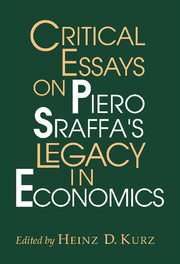Book contents
- Frontmatter
- Contents
- Preface
- List of contributors
- Part I Introduction
- Part II Returns to scale, demand, money and interest, and the classical tradition
- Part III Long-period theory and the problem of capital
- 7 The capital theory controversy
- 8 Wicksell and Douglas on distribution and marginal productivity
- 9 On the probability of re-switching and capital reversing in a two-sector Sraffian model
- Part IV Intertemporal equilibrium theory and the problem of capital
- Mathematical Note by Michele Tucci
- Author index
- Subject index
8 - Wicksell and Douglas on distribution and marginal productivity
Published online by Cambridge University Press: 05 June 2012
- Frontmatter
- Contents
- Preface
- List of contributors
- Part I Introduction
- Part II Returns to scale, demand, money and interest, and the classical tradition
- Part III Long-period theory and the problem of capital
- 7 The capital theory controversy
- 8 Wicksell and Douglas on distribution and marginal productivity
- 9 On the probability of re-switching and capital reversing in a two-sector Sraffian model
- Part IV Intertemporal equilibrium theory and the problem of capital
- Mathematical Note by Michele Tucci
- Author index
- Subject index
Summary
Production function and distribution
The hottest issue between the ‘neo-Ricardian’ and the ‘neoclassical’ schools has been the debate on capital theory, which mainly took place in the 1960s. As told from a neo-Ricardian standpoint, the dominant neoclassical school represents the technical capabilities of an economy by assuming the existence of a functional relationship (the production function F) between the amounts of ‘factors’ (capital K and labour L, land being ignored for the sake of simplicity) and their net product Q, i.e. Q = F(K, L). Function F is assumed to be well behaved (homogeneous and concave). A number of properties are derived from this conception, concerning distribution and its influence on the choice of technique k = K/L, output per worker q = Q/L, etc. However, it can shown analytically that several of these consequences are plainly wrong. To stick to the most famous argument, the neoclassical law of substitution between factors (‘the higher the remuneration of a factor, the lower its use’) is incompatible with the re-switching phenomenon, i.e. the possibility that the same technique is operated at both low and high rates of profit whereas it is dominated by another at an intermediate level: whatever the technique one classifies as more capitalistic, one of the two switchings contradicts the lesson of the law of substitution (see Sraffa, 1960). The reader may refer to Harcourt's classical book (1972) for a record of similar ‘paradoxes’ and the neo-Ricardian criticism of marginalist theory.
- Type
- Chapter
- Information
- Critical Essays on Piero Sraffa's Legacy in Economics , pp. 315 - 322Publisher: Cambridge University PressPrint publication year: 2000



